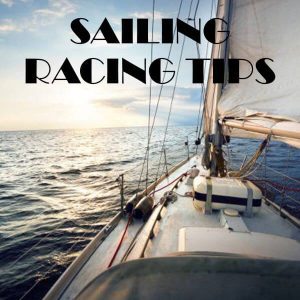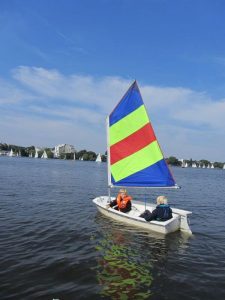In sailing, you generally raise the mainsail first. This provides better control over the boat's movement and balance. You should be aware though that different conditions and types of boat may require specific sail raising procedures.
Sailing is an exhilarating and intricate activity that requires careful attention to detail and proper sail handling.
Here you will discover which sail to raise first and crucially some simple to follow tips on how to do it quickly and successfully.

Table of Contents
- Top Tips on How to Raise the Main Sail
- Lowering it with care is also important
- Why is Raising Sails correctly so Important?
- Key takeaway:
- Importance of Raising Sails in the Correct Order
- Which Sail to Raise First in different weather Conditions?
- Tips for Raising Sails Safely
- Frequently Asked Questions
- 1. Which sail should I raise first when hoisting the sails on a sailboat?
- 2. How do I hoist the jib while sailing alone?
- 3. Should I have the centerboard up while hoisting sails?
- 4. How do I handle a boat with sails up in a crowded anchorage or in a dangerous situation?
- 5. Can I use automatic winches to raise the sails if I am struggling?
- 6. How do I prevent sail flapping and keep the boat flat while hoisting the sails?
- Read the latest Sailing Clubs posts:
Top Tips on How to Raise the Main Sail
One of the best tips is get everything ready before you even set sail. This makes it so much easier doing it in the harbour or at the marina rather than when the wind and waves or buffeting you around. So you should certainly do at least tips 1 and 2 before you even set sail.
- Unzip Sailbag
- Check the Halyard is ready to go smoothly
- Release anything that's holding down the boom
- Release the Reefing lines
- Head directly into the wind
- Go as slow as possible
- When lifting main sail it goes easy at first but when it gets to the last bit you're going to need to use the halyard to winch it up the last bit.
- Perfect halyard tension will remove all horizontal creases
- Once you've done that you can re-tension the boom vang and mainsheet. At that point you should have removed all creases vertical and horizontal.
Lowering it with care is also important
Remember these sails are expensive, so lower it carefully don't just cram it back in the bag like a scrunched up shopping bag. Do it carefully and make sure you're flaking your sail. This will prolong the life of your sail by so much it's not even funny.
Why is Raising Sails correctly so Important?
This ensures optimal sail trim, maximizing the efficiency and power of the sails. It allows for better control of the boat's speed and direction, making the sailing experience smoother and more enjoyable.
Conversely, raising sails in the wrong order can result in unbalanced forces, causing the boat to heel excessively, lose control, or even capsize.
Determining which sail to raise first depends on various factors. Sail configuration, wind strength, and the sailing angle are essential considerations. Properly assessing these factors allows sailors to choose the most effective order for raising the sails.
In different wind conditions, the order of raising sails may vary. In light winds, it is common to raise the mainsail first to catch the available breeze efficiently. In moderate winds, raising the jib or headsail before the mainsail helps maintain balance and stability. In strong winds, it is generally recommended to raise the smaller jib or a reefed mainsail first to reduce sail area and manage the boat's power appropriately.
While raising sails, it is essential to prioritize safety. Always work with a partner, communicate effectively, and use proper techniques when hoisting the sails. Clearing the deck, preparing the lines, and ensuring a secure footing are some of the tips for safely raising sails.
Key takeaway:
- Importance of raising sails in the correct order: Raising sails in the correct order is crucial for efficient sailing and maneuvering. It ensures better control and performance of the sailboat.
- What happens if sails are raised in the wrong order? Raising sails in the wrong order can lead to poor sail trim, loss of control, and decreased efficiency. It can also put the safety of the crew and the vessel at risk.
- Which sail to raise first? The order of raising sails depends on wind conditions. In light winds, it's recommended to raise the mainsail first. In moderate winds, raise the headsail first. In strong winds, start with the storm jib or a smaller headsail before adding the mainsail.
- Tips for raising sails safely: Ensure proper communication and coordination among the crew, make sure all lines are clear, and be mindful of wind direction and strength. Practice raising sails in a controlled environment before setting off on a journey.
- Conclusion: The proper order of raising sails is essential for optimal performance, safety, and control while sailing. Following the correct sequence based on wind conditions ensures a more enjoyable and successful sailing experience.
Importance of Raising Sails in the Correct Order
The importance of raising sails in the correct order cannot be overstated. Proper sail management is crucial for efficient and safe sailing. Here are the steps to follow:
- Start by hoisting the mainsail first. This is the largest and most essential sail.
- Next, raise the headsail or jib, which helps with maneuverability and balance.
- If applicable, raise any additional sails such as a spinnaker or a genoa.
- Adjust the sail trim to achieve the desired performance and maximize efficiency.
- Regularly monitor and adjust the sails as wind conditions change.
Fact: Raising sails in the correct order can significantly impact the speed, control, and overall performance of the sailboat. It ensures that each sail is set up properly to catch the wind and generate the necessary propulsion.
What Happens if Sails are Raised in the Wrong Order?
- What Happens if Sails are Raised in the Wrong Order?: When sails are raised in the wrong order, there is a risk of creating an imbalance in the boat's stability. This can lead to the boat tilting to one side, affecting its maneuverability and potentially causing it to capsize.
- Difficulty in controlling the boat: Raising sails in the wrong order can make it difficult to control the boat effectively. The incorrect placement of sails can result in uneven wind distribution, causing the boat to veer off course or lose speed.
- Reduced efficiency: If sails are raised in the wrong order, the boat may not be able to harness the full power of the wind. This leads to reduced efficiency in sailing and slower overall progress.
- Potential damage to sails and rigging: Raising sails in the wrong order can put excessive strain on the sails and rigging. This can lead to the sails tearing or the rigging becoming tangled, requiring costly repairs or replacement.
- Increased safety risks: Raising sails incorrectly can create safety risks for both the crew and the boat. The imbalance and lack of control can result in accidents, injuries, or collisions with other vessels or obstacles.
To avoid these risks, it is crucial to follow the correct order of raising sails. Take the time to learn and understand the proper sequence, and always double-check before setting sail. Regular maintenance and inspections of the sails and rigging also help to ensure their proper functioning and longevity.
Which Sail to Raise First in different weather Conditions?
We look at the situation now with different wind conditions: light winds, moderate winds, and strong winds. Get ready to discover the best strategy to optimize your sailing experience based on the wind speed. So, whether you're a seasoned sailor or a novice, prepare to navigate the seas with confidence as we unravel the secrets of sail deployment in various wind conditions.
1. Light Winds
- In light winds, it is important to raise the mainsail first. The mainsail is the largest sail on the boat and provides the most power in light winds.
- Once the mainsail is raised, you can then raise the jib or genoa. These are smaller sails that help to balance the boat and provide more lift in light winds.
- When raising the sails, it is important to do so slowly and carefully to avoid any damage to the sails or rigging.
- In light winds, it may be necessary to use additional techniques such as shaking the sails or using a boom vang to maximize the power and efficiency of the sails.
- In light winds, it is also important to constantly adjust the sails to catch the most amount of wind and maintain optimal speed.
In the 1800s, sailing was a popular mode of transportation and trade. Light winds posed a challenge for sailors as they relied solely on the wind to propel their ships. Sailors had to carefully raise their sails in the correct order to catch the minimal wind available. The mainsail was always the first to be raised in order to capture the most power from the light winds. Only after the mainsail was set would the jib or genoa be hoisted to provide additional lift. Sailors had to be skilled in reading the wind and adjusting their sails accordingly to maneuver their ships effectively in the light winds. This historical practice of raising sails in light winds has been passed down through generations of sailors and is still used today in the world of sailing.
2. Moderate Winds
- When sailing in moderate winds, it is important to follow the correct order of raising the sails for optimal performance and safety.
- The first sail to raise in moderate winds is typically the mainsail, which is the largest sail on the boat and provides the primary power and control.
- After raising the mainsail, the next sail to raise is usually the headsail. The headsail, also known as the jib or genoa, helps to balance the boat and provide additional power.
- It is important to ensure that both sails are properly trimmed and adjusted to take advantage of the wind's power and direction.
- Sailing with both the mainsail and headsail in moderate winds allows for good speed and maneuverability while maintaining stability.
Fun Fact: In moderate winds, the sails can generate enough power to propel a sailboat at a comfortable cruising speed of around 6-10 knots.
3. Strong Winds
In strong winds, it is crucial to raise sails in the correct order to ensure the safety and efficiency of sailing. Here are some factors to consider when raising sails in strong winds:
- Start with the smaller sails: In strong winds, it is recommended to raise the smaller sails first, such as the jib or staysail. These sails are usually easier to handle and control in high wind conditions.
- Reef the mainsail: When facing strong winds, it is advisable to reef the mainsail before raising it fully. Reefing involves reducing the size of the mainsail by folding or rolling part of it. This helps maintain better control of the vessel and prevents overpowering in gusty conditions.
- Secure the halyards: Before raising the sails, make sure the halyards are properly secured and tensioned. This will prevent any slippage or unexpected release of the sails while sailing in strong winds.
- Monitor the wind direction: Continuously monitor the wind direction to ensure the sails are raised to take advantage of the wind angle. Adjust the sails accordingly to optimize performance and maintain balance while sailing in strong winds.
- Use proper sail trim: Once the sails are raised, it is important to adjust the sail trim to maintain the desired shape and efficiency. In strong winds, it may be necessary to tighten the sails slightly to reduce the risk of flogging or fluttering.
- Be prepared to adjust: Sailing in strong winds can be challenging, and conditions can change quickly. Stay alert and be prepared to adjust the sail settings or even lower the sails if wind conditions become too extreme or dangerous.
By following these guidelines, you can safely navigate and control your sailboat in strong winds, ensuring a smooth and enjoyable sailing experience.
Tips for Raising Sails Safely
- Before raising the sails, it is important to inspect them for any signs of damage.
- Ensure it is safe to raise the sails by checking the wind direction and strength.
- Securely attach the halyard to the head of the sail.
- To avoid any sudden jolts or snags, raise the sail slowly and smoothly.
- Maintain control and prevent tangling by keeping a hand on the halyard at all times.
- Once the sail is fully raised, ensure proper tensioning and secure the halyard.
- To achieve the desired sail shape and angle, adjust the sheets to trim the sails.
- While underway, periodically check the sail and its attachments to ensure everything remains secure.
- When lowering the sails, proceed slowly and carefully to prevent any damage.
- Properly store the sails after use to protect them from damage and prolong their lifespan.
Frequently Asked Questions
1. Which sail should I raise first when hoisting the sails on a sailboat?
The first sail to raise on a sailboat is the mainsail, regardless of the direction of sailing.
2. How do I hoist the jib while sailing alone?
When sailing alone, it is recommended to first raise the mainsail and then hoist the jib. This order allows for easier handling of sails during the transition from motor to sail.
3. Should I have the centerboard up while hoisting sails?
It is advisable to have the centerboard up while hoisting the sails. This helps in reducing the risk of running aground and allows for smoother and safer maneuvering.
4. How do I handle a boat with sails up in a crowded anchorage or in a dangerous situation?
In crowded anchorage or in a dangerous situation, it is necessary to pay attention to the sequence of events. First, release the backwinded jib to start the boat backwards and push the bow in the desired direction. Then, as the boat drifts into position, trim in the main sail to start going forward and resheet the headsail normally. Avoid cleating anything down until clearing other boats, allowing for immediate adjustments.
5. Can I use automatic winches to raise the sails if I am struggling?
Yes, you can use automatic winches to assist in raising the sails if you are struggling. However, caution is advised while using them to prevent accidents or damage to the sails or rigging. Alternatively, considering a smaller boat with smaller sails might make hoisting easier for single-handed sailing.
6. How do I prevent sail flapping and keep the boat flat while hoisting the sails?
To prevent sail flapping and keep the boat flat while hoisting the sails, it is important to trim the main sail and keep it uncleated until ready to motor forward. This helps maintain control and stability during the transition from motor to sail. Additionally, it is recommended to hoist the jib close to the sailing area to minimize flapping and improve visibility.
Read the latest Sailing Clubs posts:
- Royal Windermere Yacht Club ReviewDid you know Lake Windermere is England's biggest lake? It's 10.5 miles long and 1 mile wide. This beautiful lake is home to the famous Royal Windermere Yacht Club. It's one of the UK's top sailing clubs, making it a great spot for sailing fans and those who love being on the water. The Royal… Read more: Royal Windermere Yacht Club Review
- Coquet Yacht Club ReviewWelcome to the Coquet Yacht Club in Amble, UK. It's known for its yachting community and great marina. Also, see why this club is so well-loved. The Coquet Yacht Club has over 500 members who love boating. They come from many different backgrounds but share a passion for sailing. This club has a long history… Read more: Coquet Yacht Club Review
- Coniston Sailing Club ReviewDid you know about the Coniston Sailing Club in the stunning Lake District? It offers many services and activities for all sailing lovers. The club's beautiful location and great facilities make it a top pick for sailing in the UK. At Coniston Sailing Club, you can learn to sail, hire a boat, or join fun… Read more: Coniston Sailing Club Review
- St Andrews Sailing Club ReviewDid you know sailing is growing fast in the UK? More people are discovering the joy of sailing. If you love sailing or want to learn, check out St Andrews Sailing Club. The club has something for everyone. From beginners to experts, you can learn and have fun. Their instructors teach you everything about sailing… Read more: St Andrews Sailing Club Review
- Derwent Reservoir Sailing Club ReviewDid you know that Derwent Reservoir in Northumberland is famous for both calm walks and exciting water sports? The Derwent Reservoir Sailing Club is loved by many. Families, water sports fans, and those who love adventure come here. The club is in Blanchland, Consett, a nice place for all. Imagine paddle boarding, dinghy sailing, windsurfing,… Read more: Derwent Reservoir Sailing Club Review
- Loch Venachar Sailing Club ReviewWelcome to Loch Venachar Sailing Club, an exciting place! Loch Venachar is in the Trossachs National Park, a top spot in the Scottish Highlands for sailing fans. This club teems with beautiful sights and fun activities, making it a perfect spot for all. Join in the fun at Loch Venachar Sailing Club with sailing lessons… Read more: Loch Venachar Sailing Club Review
- Cardwell Bay Sailing Club ReviewDid you know that sailing is not just thrilling, but also helps you see the coast's beauty? It is well-loved by water lovers around the world. Cardwell Bay Sailing Club is here for you, offering amazing sailing adventures. The club is at the gorgeous Cardwell Bay marina. It's perfect for beginners and experienced sailors alike.… Read more: Cardwell Bay Sailing Club Review
- Clyde Corinthian Yacht Club ReviewDid you know the Clyde Corinthian Yacht Club is over 140 years old? Since 1877, this club on the west coast of Scotland has welcomed sailing fans. It's a place where both new and experienced sailors come together. The club is known worldwide for its excellence in sailing. The club has great facilities like a… Read more: Clyde Corinthian Yacht Club Review
- Ullswater Yacht Club ReviewThe Lake District isn't just about beautiful views. It's also a top place for sailing. Ullswater Yacht Club brings together sailing fans to enjoy the calm and excitement of sailing. It sits in the lovely Lake District. Here, you can join regattas, rent boats, or take sailing classes. This club is known for its great… Read more: Ullswater Yacht Club Review
- Prestwick Sailing Club ReviewDid you know over 1.5 million people in the UK love sailing and water sports? Among these, Prestwick Sailing Club is a top choice. It's on the beautiful Ayrshire coast. Here, you can enjoy various activities, no matter your skill level. The club offers sailing lessons, boat rentals, and a great clubhouse. It also hosts… Read more: Prestwick Sailing Club Review
- Clyde Cruising Club ReviewDid you know the Clyde Cruising Club started in 1909? It's one of Scotland's most respected sailing clubs in Scotland. For over a century, it has been central to the area's boating history and known for its wonderful sailing experiences. In the lively city of Glasgow, the Clyde Cruising Club is a key point for… Read more: Clyde Cruising Club Review
- Dalgety Bay Sailing Club ReviewOn the north shore of the Firth of Forth, about three miles east of the Forth Rail Bridge, you'll find Dalgety Bay Sailing Club nestled in its own spacious coastal area with a convenient high tide access harbour. The WyndDalgety BayDunfermlineFifeKY11 9SJ Author John Sixthsmith I'm a freelance writer and avid sailor who loves to… Read more: Dalgety Bay Sailing Club Review
- Royal Forth Yacht Club ReviewThe Royal Forth Yacht Club is a well-established water-sports club with over 150 years of history. Located in Granton Harbour near Edinburgh, the Club offers easy access to the beautiful sailing waters of the Firth of Forth. Members can participate in a variety of racing and cruising activities, with access to fully serviced moorings and… Read more: Royal Forth Yacht Club Review
- Port Edgar Yacht Club ReviewPort Edgar Yacht Club is situated in South Queensferry, near the iconic Forth Bridges, making it easily accessible within a 60-minute drive for most individuals in the Central Belt. Whether you are new to the area, have recently completed an RYA course, or simply wish to return to sailing, they are there to assist you.… Read more: Port Edgar Yacht Club Review
- Cramond Boat Club ReviewThe Cramond Boat Club is located at the mouth of the River Almond, just four miles from the bustling centre of Edinburgh. Our Clubhouse and moorings provide a welcoming home for a variety of small craft, from dinghies to small cruisers and motorboats. The River Almond offers tidal access to the Firth of Forth for… Read more: Cramond Boat Club Review
- Which Sail to Raise First?In sailing, you generally raise the mainsail first. This provides better control over the boat's movement and balance. You should be aware though that different conditions and types of boat may require specific sail raising procedures. Sailing is an exhilarating and intricate activity that requires careful attention to detail and proper sail handling. Here you… Read more: Which Sail to Raise First?
- Bartley Green Sailing Club ReviewKey takeaways: Introduction Bartley Sailing Club offers a comprehensive review of its facilities and services. Discover the club's offerings and amenities through this informative article. Delve into the details of Bartley Sailing Club's features, ensuring you have all the necessary information before making a decision. Additionally, incorporating the provided Pro Tip will enhance your Bartley… Read more: Bartley Green Sailing Club Review
- Are Sailing Lessons Worth It?In my opinion sailing lessons are a great investment! Whether you want to be a seasoned sailor or simply have fun, learning this maritime skill can open up lots of possibilities. You'll understand wind patterns, how to navigate tricky waters, and gain boat dynamics knowledge. This maritime skill is more than what meets the eye!… Read more: Are Sailing Lessons Worth It?
- What is the Best Sailing Racing Tip?The best sailing race tip is to always maintain optimal trim. A well-trimmed sailboat will be faster and more efficient, keeping you competitive in a race. This involves constant adjustments to the sails and rigging in response to wind shifts and changes in boat speed. TLDR Apart from the above this article covers the following;… Read more: What is the Best Sailing Racing Tip?
- How much it costs to start sailing?Explore the financial aspects of starting your sailing journey. From boat purchase to maintenance costs, I break down everything you need to set sail. Based on my experience I cover all you need to know. TLDR: Sailboat Prices When it comes to sailing, one of the first questions that pop up in the mind is,… Read more: How much it costs to start sailing?
- How to start sailing if based in LondonSailing Courses in London: An Overview Finding theory courses in London isn't so difficult but actually getting on the water for practical lessons is another matter. If you are keen to learn how to sail then great but you'll need some determination to hunt out the courses you'll need. I'd suggest you check out the… Read more: How to start sailing if based in London
- How much do you tip a sailing instructorHow much to tip a sailing instructor: A guide Tipping your sailing instructor is a must! But, how much to give? Here's a guide general guide firstly, then I look at it depending whether you're in the USA, UK or Australia. General Considerations on Tipping Sailing Instructors Remember, it's about the unique boating experience and… Read more: How much do you tip a sailing instructor
- How hard is sailing?How hard is sailing? Embark on a journey through the challenges of sailing as you explore the learning curve and valuable lessons in this captivating post. Dip your toe, into sailing waters When a beginner joins their local sailing club and embarks on their first lessons, they can expect to learn a variety of the… Read more: How hard is sailing?
- How long does it take to learn sailing?Discover the journey to mastering sailing, explore the timeline and factors involved. Novice to captain, find out how long it takes to learn the art of sailing. Key Takeaways: Time Required to Learn to Sail I've always been fascinated by sailing and wanted to learn it for years now. One thing that always held me… Read more: How long does it take to learn sailing?
- What age to start sailing?Discover the ideal age to start sailing and embark on a nautical adventure. Explore the benefits and considerations for beginners in this insightful article. Key Takeaways: Introduction to Youth Sailing Sailing at a youth age is an excellent way to introduce children to the sport and instill skills that they can use throughout their life.… Read more: What age to start sailing?
- What is the difference between a yacht club and a sailing club?Introduction Explore what's the difference between a yacht club & a sailing club in my comprehensive guide. I'll help you make the right choice about which club to join. A. Brief Overview of the Topic In the world of water sports and maritime leisure activities, yacht clubs and sailing clubs are two prominent institutions that… Read more: What is the difference between a yacht club and a sailing club?
- Redditch Sailing Club, ReviewMy review of the Redditch sailing club, covers the information you need to know and our valuable insights and help for choosing a sailing club to join. Having lived in Redditch for most of my life and been a keen sailor for over 30 years I think I'm uniquely qualified to offer my opinion on… Read more: Redditch Sailing Club, Review




























